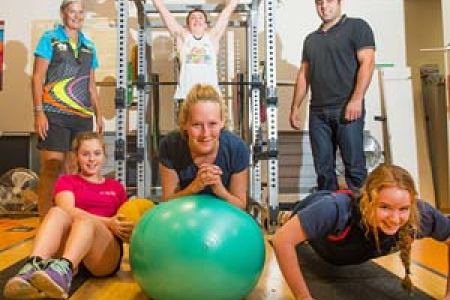Science boosts NT swimmers’ performance
A team of local swimmers has returned from the Pacific School Games free from injury and with improved personal best times after working with sports scientists at Charles Darwin University.
For the past four months swimmers from the Darwin and Nightcliff swimming clubs have worked with CDU staff and students on shoulder stability and strengthening in the lead up to the swim meet.
Darwin swimming coach Clare Labowitch said twice-weekly training sessions with CDU had a huge impact on the performance of the swimmers and minimised injury.
“Not only do the swimmers feel stronger in the water, but in almost every event we saw a marked improvement in their times,” Ms Labowitch said. “In the period of four months to have shaved seconds off times instead of splits is massive for the team.”
CDU lecturer in Exercise and Sports Science Dr Daniel Gahreman said shoulder and knee injuries were common in swimmers so they had been working on shoulder stabilisation and strengthening.
“We have been working with the swimmers to balance and strengthen shoulder, core and back muscles,” Dr Gahreman said. “For some with injuries, that has required rehabilitation sessions to fix the problem, while for others it is about building strength. Each swimmer has had an individualised training program created for them.”
A swimmer for the past eight years, shoulder injuries have plagued 16-year-old Alice Milikins. She remains passionate despite years of aching shoulders during and after training.
“I think I have been to every physio in Darwin,” she said. “Before I started training at CDU I used to go to the physio two to three times a week. Now I go once a month and I feel much stronger.”
Alongside Alice, who took eight seconds off her 400 freestyle and three seconds off her 100 metre breaststroke, other team members also smashed their personal best times in most events. Sam Bricknell shaved 12 seconds off his 200 metre individual medley while, Emily Williamson also took 13 seconds off her 200 metre backstroke.
Ms Labowitch said although coaches visited regularly from interstate to conduct training camps, the swimmers had never received individualised programs.
“It is a great opportunity for the swimmers to receive individualised strength and conditioning programs from local professionals that can be adjusted as required,” she said.
Dr Gahreman said they were now also working with the teams on assessment of stroke and breathing patterns.
“We have begun trialling sensors to test the body rotation in the water,” he said. “Early next year we hope to re-monitor the swimmers to check for improvements in stroke consistency and stabilisation of body position during swimming.”
